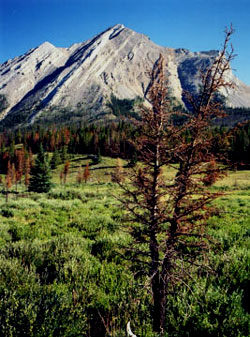
Photo: Looking north to Mount Tyrrell from Scotch Camp in the Red Deer Valley (courtesy Aaron Osicki)
Mount Tyrrell
- 2755 m (9,039ft)
Located in the Red Deer River Valley east of Divide Creek and west of Tyrrell Creek
Province: Alberta
Park: Banff
Headwater: Bow
Major Valley: Red Deer
The mountain appears on George Dawson's 1886 map as Tyrrell's Mountain. Mount Tyrrell and Mount McConnell lie adjacent to one another, although the summits are ten kilometres apart, to the north of the Red Deer River. Joseph Tyrrell and Richard McConnell were geologists who worked with Dr. Dawson. George Dawson?s map of the Canadian Rockies (from the U.S. border to the Red Deer Valley and Kicking Horse Pass) was published in 1886 and was based on his field work completed during 1883 and 1884. The map included geological surface information and six complete geological cross-sections through various points in the Rockies. He was assisted by J.B. Tyrrell in 1883 and J. White (see Mount White) in 1884. R.G. McConnell (see Mount McConnell) contributed his work in the Bow Valley that was done in 1885. As a thank you to his assistants, Dawson named three peaks in the lower headwaters on the Red Deer Valley near what is known as Scotch Camp. J.B. Tyrrell (1858-1957) attended the University of Toronto, graduating in 1880. His worked as an assistant to paleontologist J.F. Whiteaves (see Mount Whiteaves), unpacking and organizing the Geological Survey of Canada's collection of rocks an fossils. After accompanying Dawson during his 1883 explorations, Tyrrell worked in the lower Red Deer Valley in 1884 where he excavated the nearly intact head of a previously unknown species of dinosaur, now called Albertosaurus sarcophagus. He was also the first to note the existence of one of the largest coal deposits in Canada near Drumheller. He travelled widely with GSC. His work included studying and mapping in the Arctic and visiting Dawson City at the height of the gold rush in 1898. In 1899, Tyrrell left the GSC and became involved in the Klondike as a prospector, mining consultant, and surveyor and later worked in this capacity in Ontario and other areas in northwestern Canada. His successes with the Kirkland Lake Gold Mine made him a very wealthy man. Throughout his life he was keenly interested in the history of the fur trade. He collected documents related to it including, in 1895, the unpublished manuscript of David Thompson's narrative which he edited for publication. In 1985 he was posthumously honoured by the naming of the Royal Tyrrell Museum of Paleaontology in Drumheller, Alberta, commemmorating his early discovery of dinosaur remains in the Red Deer River valley in 1884.